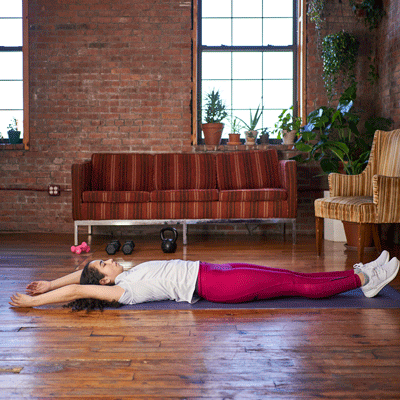A hollow hold — also known as a hollow body hold — is a movement that targets your entire core, from top to bottom and side to side. It will also help in other movements, such as pull-ups, because it helps you practice stability in your body.
You’ll often see athletes, particularly gymnasts, practice this movement, since it’s the foundation of many of the moves they have to execute.
To get the most out of this move, you’ll need to know how to do it properly and get familiar with its progressions. We’ve got you covered.
Yes, you’re essentially lying down. But this type of lying down takes a lot of effort.
Steps for a proper hollow hold:
- Lie faceup (preferably on something comfortable, like a yoga mat). Make sure arms and legs are straight.
- Press your lower back into the floor. You want zero space between your back and the floor.
- Raise arms and legs off the floor. There can be some variation in height, but the main goal is to fully engage your core. Aim for 2–3 inches, but adjust as needed.
- Lift head and shoulders off the floor, making sure not to tuck chin into chest.
- Hold for time. Start with 10 seconds and then 20. As you progress, you’ll be able to maintain this position longer.
Important safety tips: Make sure your lower back is touching the floor the entire time. Think of actively driving your lower back down into the floor and bracing your core. Your ankles should be flexed, and your toes should be pointed. Your body should look like a shallow U or a banana.
If you’re having difficulty maintaining the fully extended position, try some of these progressions:
- Bent legs. While lying on your back, lift your knees so they’re at a 90-degree angle. Lift your arms a few inches off the floor on either side of you, toward your toes. Make sure your body isn’t crunching to maintain this position. Keep working on this until you can go on to the next progression.
- Straight legs. Extend your legs above you so they’re sticking straight toward the ceiling.
- Extended legs. Slowly, over time as you become more comfortable, lower your legs toward the floor.
- Standard position. Once you can fully extend your legs while keeping your lower back in the correct position, progress your arms so they’re overhead.
Remember, the key to all these positions is to engage your core and keep your head and shoulders elevated. Your whole body should be in tension: Your quads and glutes should be engaged, your ankles should be flexed, and your ribs should be tucked down.
If you want to challenge yourself even more, use the variations below.
Hollow body crunch
A hollow body crunch is a variation that adds movement. Adding a crunch to the effort will increase core activation while still requiring stabilization at the start and finish of each rep.
- Start in a standard hollow hold position.
- Bring arms and legs together like you’re doing a crunch, touching knees with elbows.
- Return to the hollow hold position.
It’s important that you don’t let your body flop back onto the floor after each rep. You want to maintain the hollow body position throughout the movement.
Hollow body mobility
If you want to work on core stabilization while practicing your mobility, this is the variation for you. You’ll need something light to hold in your hands, like a PVC pipe or a broomstick.
- Start in the standard hollow hold position, holding the pipe/broomstick across your body in both hands.
- Lift upper body off the floor and bring knees to chest.
- Bring the pipe/broomstick under your feet and toward your glutes and extend legs over top.
- Return knees to chest and bring the pipe back over, ending in your standard hollow hold position.
Hollow body rock
The hollow body rocks is a variation that translates well to movements you’d do on a bar, like pull-ups, chin-ups, toes-to-bar, or muscle-ups.
- Start in the standard hollow body hold position.
- Rock your body from top to bottom. Minimize any movements at hips and shoulders by using your core to move your body
Weighted hollow body hold
This is a very simple yet very challenging progression. For this movement, you’ll hold some weight in your hands. You can use a plate, a dumbbell, a kettlebell, a medicine ball — whatever is most comfortable in your hands and allows you to perform the movement correctly.
Hollow body hold with resistance pull-down
This variation stabilizes your core while working your upper body. It’s very challenging, so if at any point you feel your lower body coming off the floor, try some of the other variations above. You’ll need a PVC pipe and a resistance band here.
- Tie one end of your resistance band to a pole that can bear your weight. Pull the pipe through the other end of the loop.
- Holding the pipe in your hand, start in the standard hollow hold position.
- In a controlled fashion, pull the pipe toward your feet, stopping at your hips. Hold for 1–2 seconds.
- Return to standard hollow hold position. That’s 1 rep.
The hollow hold and its variations are a key way to work on stabilizing your core. As long as you’re diligent in maintaining proper form, you should see your core strength improve — not to mention other key benefits like improved posture, reduced lower back pain, and better balance.
Whether you’re an athlete looking for increased strength, an aspiring gymnast who wants to nail a headstand, or just someone who wants stronger abdominal muscles, this is a perfect movement to add to your workout routines.


